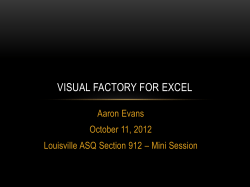
BONSAI WG on Global Impact Assessment (GIA)
BONSAI WG on Global Impact Assessment (GIA) Minutes of second meeting; 2015-‐05-‐08 7:00-‐8:00 CET Hotel Barcelona Princess, Av. Diagonal 1, Barcelona, Spain. Minutes by Bo Weidema Members present Present: Peter Fantke (PF), Massimo Pizzol (MP), Olivier Jolliet (OJ), Bo Weidema (BW) Excused: Andrew D. Henderson (ADH), Anne-‐Marie Boulay, Serenella Sala 1. Update on members BW reported that 3 new members have joined the group: Tom Gloria, Catherine Benoit, and Ricardo Teixeira. 2. Taxonomy work BW explained the current taxonomy spreadsheet that is available in the dropbox. It is a list that started out as a simple alphabetical list of all thinkable impact categories, but which got its present shape by adding the second column on “Nature of environmental mechanism” in dialogue with the "mode of contact" heading of Bare & Gloria’s 2008 attempt at a both exhaustive and non-‐overlapping taxonomy. This column proved to be very fruitful for structuring the many diverse midpoint categories, and the Excel file is currently sorted according to this column. Obviously, a full assessment and discussion of any taxonomy can only be made once each of the headings are supported by a text description and more importantly a method and unit of measurement allowing for a mathematical expression of the relations between different impacts and steps in the impact pathways. The first column distinguishes midpoints, endpoints and single-‐score. OJ suggested that “Internal costs” should not be an endpoint, since any physical flow can be either internal or external, depending on the extent to which the flow is covered by a compensating monetary exchange. Rather, this could be seen as a property of the physical flows, making possible the distinction between internal (compensated) or external (uncompensated) impacts at any point in the impact pathways. The second column categorises the environmental mechanisms, i.e. the nature of the main pathway leading to each midpoint. The purpose of this categorisation is to suggest reuse of modelling to reduce redundancy. The third column contains the name of the midpoint. MP suggested that the table might better be designed as a matrix where the midpoints occur on both axes, once as starting point and once as endpoint for the steps in the impact pathway. The fields in such a matrix would then be where the environmental mechanism was described and eventually quantified. Some of the listed midpoints may in fact rather be pressure indicators (inventory indicators). For example, the impact pathway “Biological contamination of food and freshwater” (pressure) ! “Infectious disease” (midpoint) ! “Human health” (endpoint along with several others) could in matrix format look like this: Production and consumption activities Biological contamination Infectious disease Production and consumption activities Biological contamination x x Infectious disease x Human health x where columns is causing impacts, and rows are caused impacts. As this example shows, the matrix format also makes it possible to link back to the technosphere (production and consumption) activities, e.g. to account for the added treatment costs. OJ mentioned also the feedback of impacts on the maintenance costs of historical buildings, as an example. Columns D to F in the Excel sheet point out that many impact categories contribute to more than one endpoint, something that will be also more clear in a matrix format. BW said that the Excel file currently do not distinguish between instrumental and intrinsic aspects of each endpoint, since nearly all pathways will lead to impacts on both. Column H allows addition of comments and column I addition of tags for sorting. Currently the only tag is “traditional” to distinguish the impact categories typically included in current LCIA methods. ADH had sent an e-‐mail prior to the meeting with detailed comments and questions on some specific issues in the Excel sheet. There was not time enough to discuss these at the meeting, but BW will reply to ADH. BW will provide a new version of the Excel sheet with the above suggestions incorporated. 3. Scientific article writing BW quickly presented the scientific article outline on the etherpad. The general structure was agreed to be adequate. BW volunteered to take responsibility for the chapters “Core definitions” and “Environmental mechanisms”, which may then be commented by the rest of the group. PF and OJ agreed to then take the responsibility for some of the other chapters, mainly on impact categories and pathways. MP will contribute when back from his paternity leave. The etherpad remains open for any member to contribute at any time. 4. AOB BW will provide a doodle for a next meeting, which will be held via GoToMeeting.
© Copyright 2025










